

Compact Muon Solenoid
LHC, CERN
| CMS-PAS-HIG-17-003 | ||
| Search for the associated production of a Higgs boson with a top quark pair in final states with a $\tau$ lepton at $\sqrt{s} = $ 13 TeV | ||
| CMS Collaboration | ||
| March 2017 | ||
| Abstract: Results of a search for the standard model Higgs boson produced in association with a top quark pair in final states with $\tau$ leptons are presented. The analyzed dataset corresponds to an integrated luminosity of 35.9 fb$^{-1}$ which has been recorded in proton-proton collisions at $\sqrt{s} = $ 13 TeV center-of-mass energy by the CMS experiment during LHC Run-2. The sensitivity of the search is improved by using matrix element and machine learning methods to separate the signal from backgrounds. The measured signal rate amounts to 0.72$^{+0.62}_{-0.53}$ times the production rate expected in the standard model, with an observed (expected) significance of 1.4$\sigma$ (1.8$\sigma$). An upper limit on the signal rate of 2.0 the standard model production rate is set at the 95% confidence level. | ||
| Links: CDS record (PDF) ; inSPIRE record ; CADI line (restricted) ; | ||
| Figures | |

png pdf |
Figure 1:
A typical Feynman diagram for ttH production with subsequent decay of the H boson to a pair of $\tau$ leptons. |

png pdf |
Figure 2:
Distributions in the discriminating observables used for the signal extraction in the 1${\ell }$+2$ {\tau _{\textrm {h}}} $ (top left) and 3${\ell }$+1$ {\tau _{\textrm {h}}} $ (top right) categories and in the "no-missing-jet'' (bottom left) and "missing-jet'' (bottom right) subcategories of the 2$\ell$-ss+1$\tau_{\mathrm{h}}$ category, compared to the SM expectation for the ttH signal and for background processes. The distributions expected for the ttH signal and for the backgrounds are shown for the values of nuisance parameters obtained from the maximum likelihood fit. The lowest bin of the MEM discriminant in the "missing-jet'' subcategory collects events for which the kinematics of the reconstructed objects is not compatible with the ttH, $ { {\mathrm {H}} }\to \tau \tau $ signal hypothesis. |
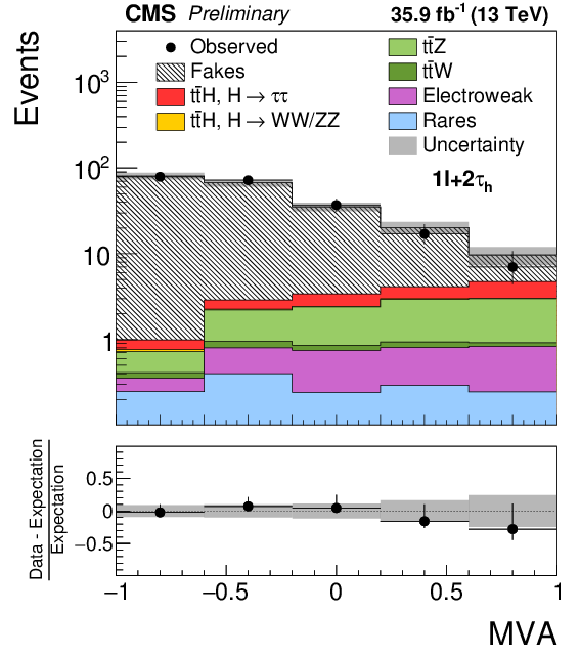
png pdf |
Figure 2-a:
Distribution in the discriminating observable used for the signal extraction in the 1${\ell }$+2$ {\tau _{\textrm {h}}} $ category, compared to the SM expectation for the ttH signal and for background processes. The distributions expected for the ttH signal and for the backgrounds are shown for the values of nuisance parameters obtained from the maximum likelihood fit. |
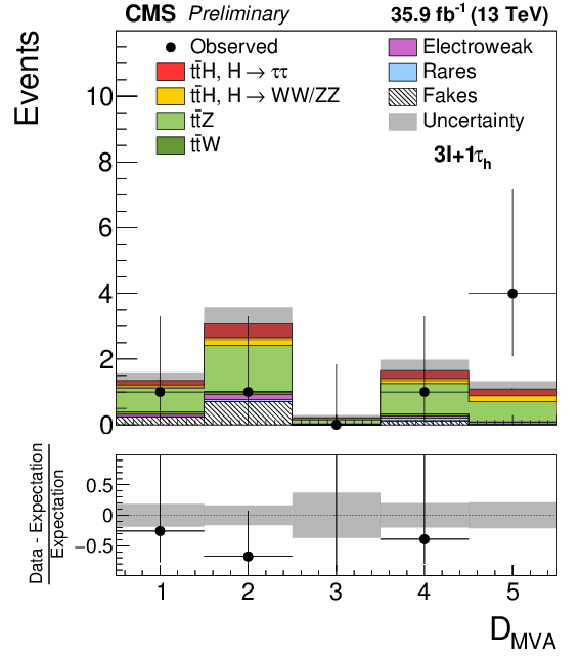
png pdf |
Figure 2-b:
Distribution in the discriminating observable used for the signal extraction in the 3${\ell }$+1$ {\tau _{\textrm {h}}} $ category, compared to the SM expectation for the ttH signal and for background processes. The distributions expected for the ttH signal and for the backgrounds are shown for the values of nuisance parameters obtained from the maximum likelihood fit. |
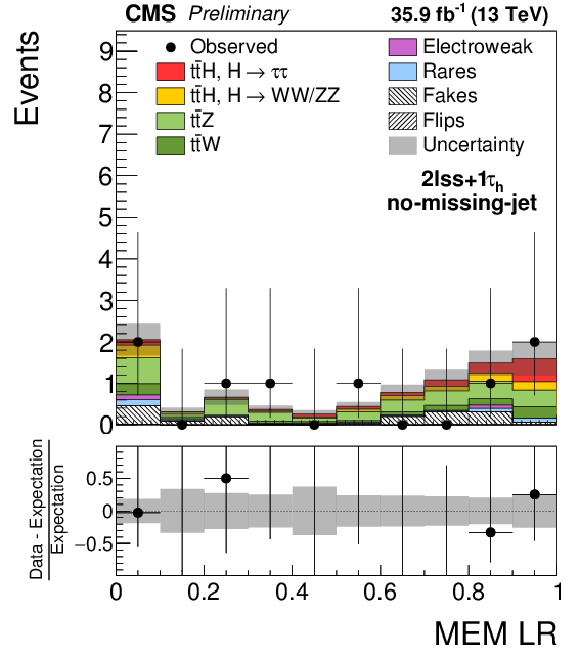
png pdf |
Figure 2-c:
Distribution in the discriminating observable used for the signal extraction in the "no-missing-jet'' subcategory of the 2$\ell$-ss+1$\tau_{\mathrm{h}}$ category, compared to the SM expectation for the ttH signal and for background processes. The distributions expected for the ttH signal and for the backgrounds are shown for the values of nuisance parameters obtained from the maximum likelihood fit. |
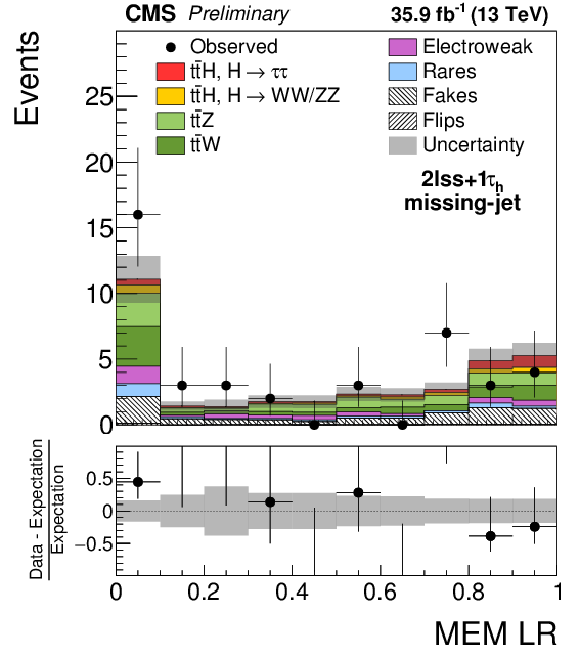
png pdf |
Figure 2-d:
Distribution in the discriminating observable used for the signal extraction in the "missing-jet'' subcategory of the 2$\ell$-ss+1$\tau_{\mathrm{h}}$ category, compared to the SM expectation for the ttH signal and for background processes. The distributions expected for the ttH signal and for the backgrounds are shown for the values of nuisance parameters obtained from the maximum likelihood fit. The lowest bin of the MEM discriminant collects events for which the kinematics of the reconstructed objects is not compatible with the ttH, $ { {\mathrm {H}} }\to \tau \tau $ signal hypothesis. |
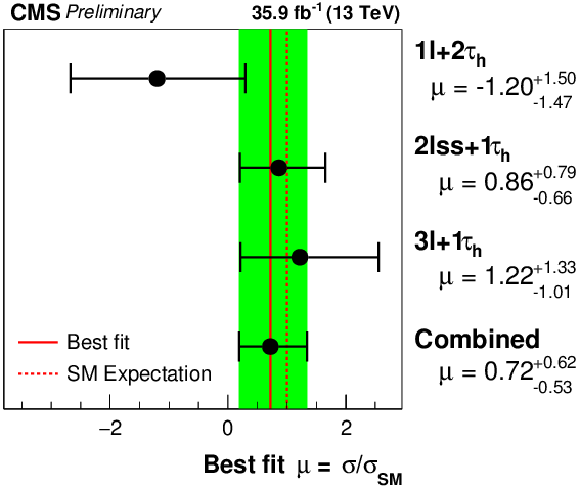
png pdf |
Figure 3:
Signal rates $\mu $, in units of the SM ttH production rate, measured in each of the categories 2$\ell$-ss+1$\tau_{\mathrm{h}}$, 3${\ell }$+1$ {\tau _{\textrm {h}}} $, and 1${\ell }$+2$ {\tau _{\textrm {h}}} $ individually and for the combination of all three categories. |
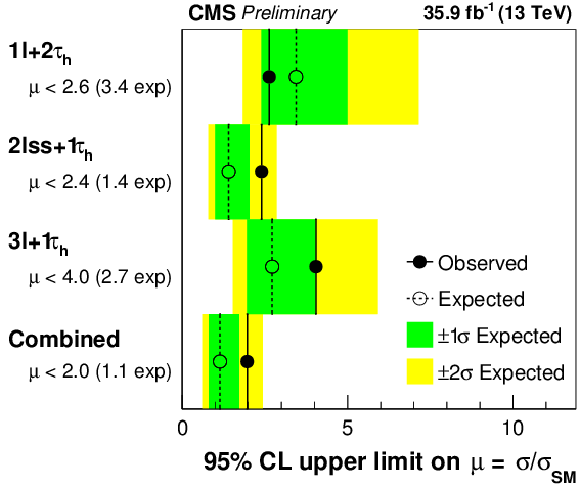
png pdf |
Figure 4:
95% CL upper limits on the ttH signal rate, obtained in each of the categories 2$\ell$-ss+1$\tau_{\mathrm{h}}$, 3${\ell }$+1$ {\tau _{\textrm {h}}} $, and 1${\ell }$+2$ {\tau _{\textrm {h}}} $ individually and for the combination of all three event categories. The expected limits are computed for the background-only ($\mu =$ 0) hypothesis. |
| Tables | |
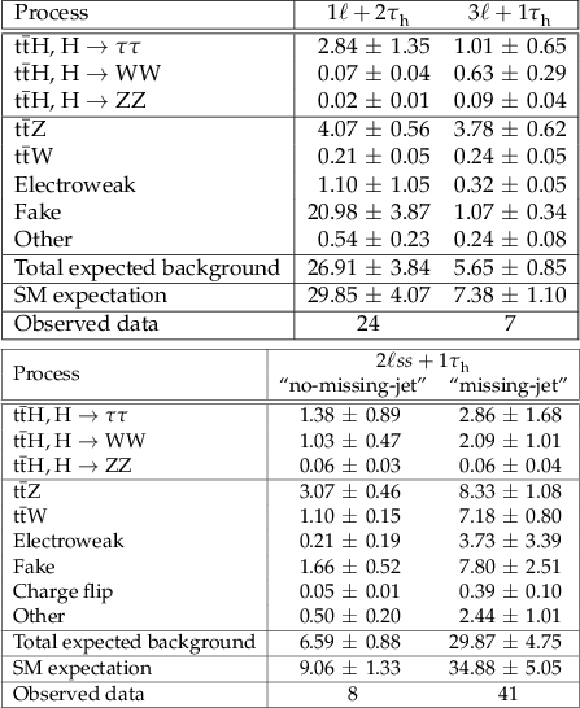
png pdf |
Table 1:
Number of events events selected in the 2$\ell$-ss+1$\tau_{\mathrm{h}}$, 3${\ell }$+1$ {\tau _{\textrm {h}}} $, and 1${\ell }$+2$ {\tau _{\textrm {h}}} $ categories compared to the SM expectation for the ttH signal and background processes. The event yield in the 1${\ell }$+2$ {\tau _{\textrm {h}}} $ category is given in the signal-like region MVA $ >$ 0.2 of the output of the BDT that is used for the signal extraction. The event yields expected for the ttH signal and for the backgrounds are shown for the values of nuisance parameters obtained from the maximum likelihood fit. Quoted uncertainties represent the combination of statistical and systematic uncertainties. |

png pdf |
Table 2:
Signal rates $\mu $, in units of the SM ttH production rate, measured and expected in each of the categories 2$\ell$-ss+1$\tau_{\mathrm{h}}$, 3${\ell }$+1$ {\tau _{\textrm {h}}} $, and 1${\ell }$+2$ {\tau _{\textrm {h}}} $ individually and for the combination of all three categories. |

png pdf |
Table 3:
95% CL upper limits on the ttH signal rate, in units of the SM ttH production rate, obtained in each of the categories 2$\ell$-ss+1$\tau_{\mathrm{h}}$, 3${\ell }$+1$ {\tau _{\textrm {h}}} $, and 1${\ell }$+2$ {\tau _{\textrm {h}}} $ individually and for the combination of all three event categories. The observed limit is compared to the limits expected for the background-only hypothesis ($\mu =$ 0) and for the case that a ttH signal of SM production rate is present in the data ($\mu =$ 1). The limits expected in the case $\mu =$ 1 are computed using an Asimov dataset, while the limits expected in the case $\mu =$ 0 are computed for the values of nuisance parameters obtained from a maximum likelihood fit of the background-only hypothesis to the data. The $\pm$1$ \sigma $ uncertainty intervals of the limits expected in case of the background-only hypothesis are also given in the table. |
| Summary |
| A search for the associated production of a Higgs boson with top quark pair in final states with a $\tau$ lepton has been presented. The analyzed dataset corresponds to 35.9 fb$^{-1}$ of pp collision data recorded in 2016 by the CMS experiment at $\sqrt{s}=$ 13 TeV. The analysis is performed in three event categories: 1$\ell$+2$\tau_{\mathrm{h}}$, 2$\ell$-ss+1$\tau_{\mathrm{h}}$ and 3$\ell$+1$\tau_{\mathrm{h}}$. The sensitivity of the analysis is enhanced by using multivariate analysis techniques, based on the matrix element method and boosted decision trees. The results of the analysis are in agreement with the SM expectation. The measured signal rate amounts to 0.72$^{+0.62}_{-0.53}$ times the SM ttH production rate, with an observed (expected) significance of 1.4$\sigma$ (1.8$\sigma$). An upper limit on the signal rate of 2.0 times the SM ttH production rate at 95% CL is set. |
| References | ||||
| 1 | CMS Collaboration | Observation of a new boson at a mass of 125 GeV with the CMS experiment at the LHC | PLB 716 (2012) 30 | CMS-HIG-12-028 1207.7235 |
| 2 | ATLAS Collaboration | Observation of a new particle in the search for the Standard Model Higgs boson with the ATLAS detector at the LHC | PLB 716 (2012) 1 | 1207.7214 |
| 3 | ATLAS, CMS Collaboration | Combined measurement of the Higgs boson mass in pp collisions at $ \sqrt{s}= $ 7 and 8 TeV with the ATLAS and CMS experiments | PRL 114 (2015) 191803 | 1503.07589 |
| 4 | ATLAS Collaboration | Search for the Standard Model Higgs boson produced in association with top quarks and decaying into $ \mathrm{b}\bar{ \mathrm{b} } $ in pp collisions at $ \sqrt{s} = $ 8 TeV with the ATLAS detector | EPJC 75 (2015), no. 7, 349 | 1503.05066 |
| 5 | ATLAS Collaboration | Search for the Standard Model Higgs boson decaying into $ \mathrm{b}\bar{ \mathrm{b} } $ produced in association with top quarks decaying hadronically in pp collisions at $ \sqrt{s}= $ 8 TeV with the ATLAS detector | JHEP 05 (2016) 160 | 1604.03812 |
| 6 | ATLAS Collaboration | Search for the associated production of the Higgs boson with a top quark pair in multilepton final states with the ATLAS detector | PLB 749 (2015) 519 | 1506.05988 |
| 7 | ATLAS Collaboration | Search for $ \mathrm{ H } \to \gamma\gamma $ produced in association with top quarks and constraints on the Yukawa coupling between the top quark and the Higgs boson using data taken at 7 TeV and 8 TeV with the ATLAS detector | PLB 740 (2015) 222 | 1409.3122 |
| 8 | ATLAS Collaboration | Combination of the searches for Higgs boson production in association with top quarks in the $ \gamma\gamma $, multilepton, and $ \mathrm{b}\bar{ \mathrm{b} } $ decay channels at $ \sqrt{s}= $ 13 TeV with the ATLAS detector | ATLAS Conference Note ATLAS-CONF-2016-068 | |
| 9 | CMS Collaboration | Search for the associated production of the Higgs boson with a top-quark pair | JHEP 09 (2014) 087 | CMS-HIG-13-029 1408.1682 |
| 10 | CMS Collaboration | Search for a Standard Model Higgs boson produced in association with a top-quark pair and decaying to bottom quarks using a matrix element method | EPJC 75 (2015), no. 6, 251 | CMS-HIG-14-010 1502.02485 |
| 11 | CMS Collaboration | Search for ttH production in the $ \mathrm{ H } \to \mathrm{b}\bar{ \mathrm{b} } $ decay channel with $ \sqrt{s}= $ 13 TeV pp collisions at the CMS experiment | CMS-PAS-HIG-16-004 | CMS-PAS-HIG-16-004 |
| 12 | CMS Collaboration | Search for associated production of Higgs bosons and top quarks in multilepton final states at $ \sqrt{s}= $ 13 TeV | ||
| 13 | CMS Collaboration | Updated measurements of Higgs boson production in the diphoton decay channel at $ \sqrt{s}= $ 13 TeV in pp collisions at CMS | CMS-PAS-HIG-16-020 | CMS-PAS-HIG-16-020 |
| 14 | K. Kondo | Dynamical likelihood method for reconstruction of events with missing momentum. 1: method and toy models | J. Phys. Soc. Jap. 57 (1988) 4126--4140 | |
| 15 | K. Kondo | Dynamical likelihood method for reconstruction of events with missing momentum. 2: mass spectra for 2$ \to $2 processes | J. Phys. Soc. Jap. 60 (1991) 836--844 | |
| 16 | A. Hocker et al. | TMVA - toolkit for multivariate data analysis | PoS ACAT (2007) 040 | physics/0703039 |
| 17 | F. Pedregosa et al. | Scikit-learn: Machine Learning in Python | Journal of Machine Learning Research 12 (2011) 2825 | |
| 18 | CMS Collaboration | Description and performance of track and primary-vertex reconstruction with the CMS tracker | JINST 9 (2014) P10009 | CMS-TRK-11-001 1405.6569 |
| 19 | CMS Collaboration | The CMS experiment at the CERN LHC | JINST 3 (2008) S08004 | CMS-00-001 |
| 20 | J. Alwall et al. | The automated computation of tree-level and next-to-leading order differential cross sections, and their matching to parton shower simulations | JHEP 07 (2014) 079 | 1405.0301 |
| 21 | P. Nason | A new method for combining NLO QCD with shower Monte Carlo algorithms | JHEP 11 (2004) 040 | hep-ph/0409146 |
| 22 | S. Frixione, P. Nason, and C. Oleari | Matching NLO QCD computations with parton shower simulations: the POWHEG method | JHEP 11 (2007) 070 | 0709.2092 |
| 23 | S. Alioli, P. Nason, C. Oleari, and E. Re | A general framework for implementing NLO calculations in shower Monte Carlo programs: the POWHEG BOX | JHEP 06 (2010) 043 | 1002.2581 |
| 24 | NNPDF Collaboration | Parton distributions with QED corrections | Nucl. Phys. B 877 (2013) 290 | 1308.0598 |
| 25 | NNPDF Collaboration | Unbiased global determination of parton distributions and their uncertainties at NNLO and at LO | Nucl. Phys. B 855 (2012) 153 | 1107.2652 |
| 26 | NNPDF Collaboration | Parton distributions for the LHC Run II | JHEP 04 (2015) 040 | 1410.8849 |
| 27 | CMS Collaboration | Event generator tunes obtained from underlying event and multiparton scattering measurements | CMS-GEN-14-001 1512.00815 |
|
| 28 | P. Skands, S. Carrazza, and J. Rojo | Tuning PYTHIA 8.1: the Monash 2013 tune | EPJC 74 (2014), no. 8 | 1404.5630 |
| 29 | K. Melnikov and F. Petriello | Electroweak gauge boson production at hadron colliders through O($ \alpha_{s}^{2} $) | PRD 74 (2006) 114017 | hep-ph/0609070 |
| 30 | M. Czakon and A. Mitov | Top++: A program for the calculation of the top-pair cross section at hadron colliders | CPC 185 (2014) 2930 | 1112.5675 |
| 31 | CMS Collaboration | Measurement of differential top-quark pair production cross sections in pp colisions at $ \sqrt{s} = $ 7 TeV | EPJC 73 (2013) 2339 | CMS-TOP-11-013 1211.2220 |
| 32 | CMS Collaboration | Measurement of the differential cross section for top quark pair production in pp collisions at $ \sqrt{s} = $ 8 TeV | EPJC 75 (2015), no. 11, 542 | CMS-TOP-12-028 1505.04480 |
| 33 | Kant, P. and Kind, O. M. and Kintscher, T. and Lohse, T. and Martini, T. and M\"olbitz, S. and Rieck, P. and Uwer, P. | HATHOR for single top-quark production: Updated predictions and uncertainty estimates for single top-quark production in hadronic collisions | CPC 191 (2015) 74 | 1406.4403 |
| 34 | M. Aliev et al. | HATHOR: HAdronic Top and Heavy quarks crOss section calculatoR | CPC 182 (2011) 1034--1046 | 1007.1327 |
| 35 | N. Kidonakis | Two-loop soft anomalous dimensions for single top quark associated production with a $ \mathrm{ W }^{-} $ or $ \mathrm{ H }^{-} $ | PRD 82 (2010) 054018 | 1005.4451 |
| 36 | J. M. Campbell, R. K. Ellis, and C. Williams | Vector boson pair production at the LHC | JHEP 07 (2011) 018 | 1105.0020 |
| 37 | GEANT4 Collaboration | GEANT4---a simulation toolkit | NIMA 506 (2003) 250 | |
| 38 | CMS Collaboration | Performance of reconstruction and identification of $ \tau $ leptons in their decays to hadrons and $ \nu_{\tau} $ in LHC Run $ 2 $ | CMS-PAS-TAU-16-002 | CMS-PAS-TAU-16-002 |
| 39 | CMS Collaboration | Identification of b quark jets with the CMS experiment | JINST 8 (2013) P04013 | CMS-BTV-12-001 1211.4462 |
| 40 | CMS Collaboration | Performance of missing energy reconstruction in 13 TeV pp collision data using the CMS detector | CMS-PAS-JME-16-004 | CMS-PAS-JME-16-004 |
| 41 | CMS Collaboration | Performance of the CMS missing transverse momentum reconstruction in pp data at $ \sqrt{s} = $ 8 TeV | JINST 10 (2015), no. 02, P02006 | CMS-JME-13-003 1411.0511 |
| 42 | CMS Collaboration | Particle-flow event reconstruction in CMS and performance for jets, taus, and $ E_{\mathrm{T}}^{\text{miss}} $ | CDS | |
| 43 | CMS Collaboration | Commissioning of the particle-flow event reconstruction with the first LHC collisions recorded in the CMS detector | CDS | |
| 44 | CMS Collaboration | Commissioning of the particle-flow reconstruction in minimum-bias and jet events from pp collisions at 7 TeV | CDS | |
| 45 | CMS Collaboration | Particle-flow commissioning with muons and electrons from $ \mathrm{J}/\psi $ and $ \mathrm{ W } $ events at 7 TeV | CDS | |
| 46 | E. Chabanat and N. Estre | Deterministic annealing for vertex finding at CMS | in Computing in high energy physics and nuclear physics. Proceedings, Conference, CHEP'04, 2004 | |
| 47 | W. Waltenberger, R. Fr\"uhwirth, and P. Vanlaer | Adaptive vertex fitting | JPG: Nucl. Part. Phys. 34 (2007) N343 | |
| 48 | M. Cacciari, G. P. Salam, and G. Soyez | The anti-$ \kT $ jet clustering algorithm | JHEP 04 (2008) 063 | 0802.1189 |
| 49 | S. Baffioni et al. | Electron reconstruction in CMS | EPJC 49 (2007) 1099 | |
| 50 | W. Adam, R. Fr\"uhwirth, A. Strandlie, and T. Todorov | Reconstruction of electrons with the Gaussian sum filter in the CMS tracker at LHC | JPG: Nucl. Part. Phys. 31 (2003) N9 | physics/0306087 |
| 51 | CMS Collaboration | Performance of electron reconstruction and selection with the CMS detector in pp collisions at $ \sqrt{s} = $ 8 TeV | JINST 10 (2015), no. 06, P06005 | CMS-EGM-13-001 1502.02701 |
| 52 | CMS Collaboration | Performance of CMS muon reconstruction in pp collision events at $ \sqrt{s} = $ 7 TeV | JINST 7 (2012) P10002 | CMS-MUO-10-004 1206.4071 |
| 53 | CMS Collaboration | Reconstruction and identification of $ \tau $ lepton decays to hadrons and $ \nu_{\tau} $ at CMS | JINST 11 (2016), no. 01, P01019 | CMS-TAU-14-001 1510.07488 |
| 54 | CMS Collaboration | Jet performance in pp collisions at $ \sqrt{s} = $ 7 TeV | CDS | |
| 55 | CMS Collaboration | Determination of jet energy calibration and transverse momentum resolution in CMS | JINST 6 (2011) P11002 | CMS-JME-10-011 1107.4277 |
| 56 | M. Cacciari, G. P. Salam, and G. Soyez | The catchment area of jets | JHEP 04 (2008) 005 | 0802.1188 |
| 57 | M. Cacciari and G. P. Salam | Pileup subtraction using jet areas | PLB 659 (2008) 119 | 0707.1378 |
| 58 | CMS Collaboration | CMS luminosity measurement for the 2016 data-taking period | ||
| 59 | LHC Higgs Cross Section Working Group Collaboration | Handbook of LHC Higgs Cross Sections: 3. Higgs Properties: Report of the LHC Higgs Cross Section Working Group | CERN-2013-004 | |
| 60 | R. Barlow and C. Beeston | Fitting using finite Monte Carlo samples | CPC 77 (1993)219 | |
| 61 | J. S. Conway | Incorporating nuisance parameters in likelihoods for multisource spectra | 1103.0354 | |
| 62 | A. L. Read | Modified frequentist analysis of search results (the $ CL_{s} $ method) | in Workshop on confidence limits, CERN, Geneva, Switzerland, 2000 | |
| 63 | J. D. Bjorken | Asymptotic sum rules at infinite momentum | PR179 (1969) 1547 | |
| 64 | P. M. Nadolsky et al. | Implications of CTEQ global analysis for collider observables | PRD78 (2008) 013004 | 0802.0007 |
| 65 | G. P. Lepage | A new algorithm for adaptive multidimensional integration | J. Comput. Phys. 27 (1978) 192 | |
| 66 | J. Neyman | Outline of a theory of statistical estimation based on the classical theory of probability | Philosophical transactions of the royal society of London. Series A, mathematical and physical sciences 236 (1937) | |

|
Compact Muon Solenoid LHC, CERN |

|

|

|

|

|

|